Definition of Vedic Jyotish
With the help of Vedic Jyotish (astrology), an astrologer tracks the position and inter-relation of celestial bodies and points of significance in the space, from Earth’s perspective and finds corresponding events related to past, present or future of an object in question. Lets explode the above definition -
- "track position and inter-relation" means that calculating the placement and defining the inter-relations based upon astronomy and Vedic Jyotish (astrology) rules.
- "celestial bodies and points of significance in the space" means Grahas (planets), Bhavas (arbitrary division of space around Earth) and Rashi (division of moving group of stars) etc. in the space around Earth. For the time being it's sufficient to know that in Vedic Jyotish (astrology) we have –
i) |
7 major and 2 shadow Graha (planet) i.e. 9 in all |
ii) |
12 Bhavas (arbitrary division of space around Earth) |
iii) |
12 Rashis (division of moving group of stars) |
- "from Earth’s perspective" means Vedic Jyotish (astrology) is relative to Earth i.e. from Earth's perspective. Vedic Jyotish (astrology) is geocentric (i.e. Earth in the center) and not heliocentric (i.e. Sun in the center), because we are considering the effect of celestial bodies on an object, which is present on this Earth.
- "find corresponding events" means to interpret the inter-relation of celestial bodies and points of significance into meaningful events that affects the life of an object on this Earth.
- "past, present and future" means events can be related to object's past, present or future.
- “object” means the Vedic Jyotish (astrology) can be applied on the following items –
i) |
Living organic objects such as human being, animal etc. |
ii) |
Non-living objects such as building, vehicle etc. |
iii) |
Specific moment of time such as a question or activity at a specific time. |
iv) |
Collective objects such as country, group of people etc. This is also called Mundane (collective) Vedic Jyotish (astrology). |
Steps involved in Vedic Jyotish
In Vedic Jyotish (astrology), every specific moment of time is influenced by energies of Grahas (planet) and has it's own positive and negative qualities. A person born under a particular moment of time carries these basic qualities throughout its life. To study these planetary influences and interpreting into meaningful events is called Vedic Jyotish (astrology). Based upon the planetary position at the time of birth, an Astrologer can reveal past, present and future.
So, the first step is to calculate planetary position as visible from a specific place at the time of birth of an object in question. In order to calculate the planetary position, an astrologer will require the following basic information to start with -
- Place of birth of an object, which is the name of the City in a Country. For example city Houston in USA. With this information an astrologer can determine exact position (i.e. latitude and longitude, which will be discussed later) on Earth.
- Time and date when the object was born or created. For example birth of a person can be on 11th September 2002 at 09:40 AM CST.
The above information, equips an astrologer to find out the exact planetary position on 11th September 2002 at 09:40 AM CST, visible from Houston, USA. This is done with the help of Panchang (yearly planetary almanacs), which is discussed in the next section.
Next step is to calculate the reports based upon the Vedic Jyotish’s (astrology) grammar. After analyzing and synthesizing these technical reports, an astrologer can give meaningful predictions for an object in question. Broadly, these reports (which are in the form of tables, text and graphics) can be divided into following categories -
- Astronomy reports : These reports have technical information regarding the movement and position of Graha (planets).
- Astrology reports : Astrology reports consist of technical information based upon Vedic Jyotish’s (astrology) grammar.
- Descriptive reports : Predictive text reports for end user. Depth and accuracy of these reports depends upon experience, intuition and judgment of an astrologer.
Now a days, Vedic Jyotish (astrology) software packages are capable to generate accurate Astronomy and Astrology reports, in a couple of seconds, which otherwise might take days manually!
Some software packages also generate descriptive predictions, but these predictions are generic and thus partially accurate. Generating meaningful descriptive reports for the end user is an interesting project in itself, which requires massive resources. Because computers with present technology lack in intuition (and judgment too), it may not be feasible to generate accurate descriptive reports. Refer to fig 2.1 : Typical steps involved in Vedic Jyotish (astrology).
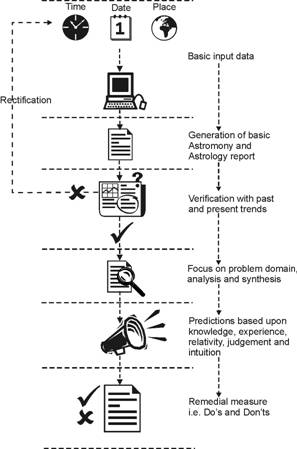
Fig 2.1 : Typical steps involved in Vedic Jyotish
Typical sequences of steps are -
- Basic input data : Date, time and place of birth of client are fed into the computer.
- Generation of basic reports : Computer generates Astronomy and Astrology reports based upon its stored Vedic Jyotish (astrology) knowledge and planetary almanacs.
- Verification : Vedic Astrologer analyzes astronomy/astrology reports and determines the strength and weakness of Kundali (horoscope). Actual past and present trends (such as ups and downs in life), environment (such as social, work or economic etc.), internal and external personality of client is verified with the generated Kundali (horoscope).
- Rectification of Kundali (horoscope) : If Kundali (horoscope) does not match with actual trends and attributes, then 1st step is repeated with different time and/or date. This is also called rectification of birth chart.
- Focus on problem domain : If Kundali (horoscope) matches with actual trends, then Vedic Astrologer will focus on problem domain. Vedic Astrologer may require further interaction to fine-tune his in-sight into Kundali (horoscope). Vedic Astrologer may also have to look into Panchanga or computer based planetary almanacs to see the current planetary trend and it's effect on the Kundali (Horoscope).
- Predictions : Judgments made, will be refined based upon the relativity (such as existing social/work/economic status, Gender, age, society and culture etc.). Then based upon experience and final derived facts Vedic Astrologer will predict the future events. At this point in time, Vedic Astrologer’s intuition will also play an important role. Existing surrounding and environment may also give him some positive or negative clues.
- Remedial measure : In order to eliminate or dilute the effect of malefic effect of Graha (planet), a Vedic Astrologer can offer remedial measures, such as worship, charity or some specific remedial measures.
Panchanga
Word Panchanga is combination of two words viz Panch (five) and Anga (limbs), which means “five limbs” -
# |
Limbs |
1 |
Tithi (Lunar date) |
2 |
Vaara (Day of week) |
3 |
Nakshtra (constellations of fixed stars i.e. Lunar asterisms) |
4 |
Yoga (Union) |
5 |
Karana (Half Lunar date) |
Panchanga is yearly almanacs of planets along with other useful information for Vedic Jyotish (astrology) astrologers as well as layman. Now a day, planetary almanacs are also available on the Internet.
In our example, these planetary almanacs help us to find the planetary position on 11th September 2002 at 09:40 AM CST, visible from Houston, USA.
Basic concept of Vedic Jyotish
To understand the basic concept behind Vedic Jyotish (astrology), we need to understand the integration of –
1) |
9 major Grahas (planets) |
2) |
12 Bhavas (arbitrary division of space around Earth) |
3) |
12 Rashis (division of moving group of stars) |
We will see how can we mix and match the 9 major Grahas (planets), 12 Bhavas (arbitrary division of space around Earth) and 12 Rashis (division of moving group of stars).
To explain the complex relationship, we will conceptualize an abstract analogue clock, which is somewhat similar to our normal clocks. We will call it “Vedic-Jyotish-Clock”. Vedic-Jyotish-Clock is little more complex than our normal clock and it has three major layer of components viz Bhava-dial, Rashi-dial and Graha hands. Let’s define the property of each component one by one.
Properties of Bhava-dial : Refer to fig 2.2 : Bhava-dial.
i) |
Circular in shape and thus has 360 degrees. |
ii) |
Opaque. |
iii) |
White in color. |
iv) |
Fixed in the background. |
v) |
Divided into 12 equal sectors. |
vi) |
Sectors are numbered from 1 to 12 in anticlockwise direction. |
vii) |
Each sector of Bhava (arbitrary division of space around Earth) is equal to 30 degree. |
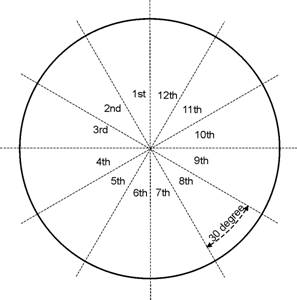
Fig 2.2 : Bhava-dial
Properties of Rashi-dial : Refer to fig 2.3 : Rashi-dial.
i) |
Circular in shape and thus has 360 degrees. |
ii) |
Transparent. |
iv) |
Resides on the top of Bhava-dial. |
v) |
Divided into 12 equal sectors. |
vi) |
Sectors are numbered from 1 to 12 in anticlockwise direction. |
v) |
Rotates on its pivot and moves sector-by-sector in anticlockwise direction. |
vii) |
Each sector of Rashi (division of moving group of stars) has it’s own unique color. |
vii) |
Each sector of Rashi (division of moving group of stars) is equal to 30 degree. |
viii) |
One Rashi (division of moving group of stars) sector is further divided into 2.33 units, which are known as Nakshtra (asterisms - constellations of fixed stars). In other words, Rashi-dial is also divided into 27 sub-sectors. |
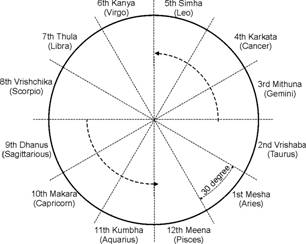
Fig 2.3 : Rashi-dial
Properties of Graha hands : Refer to fig 2.4 : Graha hands.
i) |
9 independent hands, each represents one Graha (planet). |
ii) |
Hand movement can either be clockwise or anticlockwise. Rahu (Dragon Head) and Ketu (Dragon Tail) always move clock-wise. Surya (Sun) and Chander (Moon) always move in anticlockwise direction. Mangal (Mars), Budha (Mercury), Guru (Jupiter), Shukar (Venus), Shani (Saturn) can move forward or backward. |
iii) |
A complete cycle of the 9 hands consisting of Surya (Sun), Chander (Moon), Mangal (Mars), Budh (Mercury), Bhraspati (Jupiter), Shukar (Venus), Shani (Saturn), Rahu (Dragon Head) and Ketu (Dragon Tail) is 1 year, 27 days, 2 years, 1 year, 12 years, 1 year, 30 years, 18 years and 18 years respectively. |
iv) |
Each Graha (planet) hand omits a unique color light, which can illuminate Bhava-dial sector through coincided transparent Rashi-dial sector. |
v) |
Intensity and nature of light keeps on changing. |
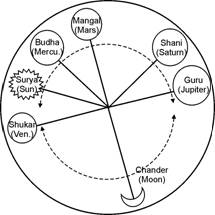
Fig 2.4 : Graha hands
In Vedic-Jyotish-Clock, Rashi-dial and 9 Grahas (planets) hands keeps on changing it’s positions, with respect to Bhava-dial, which is fixed in the background.
Now, at the time of birth of an object, a Vedic Jyotish (astrology) astrologer will take a snapshot of this clock and try to interpret the color, which each sector of Bhava (arbitrary division of space around Earth) is getting via each sector of Rashi-dial.
In this example, let’s focus on sector 10 of Bhava. Sector 10 of Bhava is coincided with sector 3 of Rashi-dial and Graha hand number 5 on the top of sector 3 of Rashi-dial. Let’s assume that Graha hand is omitting Yellow light on transparent sector 3 of Rashi-dial, which is Red in color. Because of combination of Yellow and Red, sector 10 of Bhava-dial, will receive Orange light. Refer to fig 2.5 : Vedic-Jyotish-Clock top view and fig 2.6 : Vedic-Jyotish-Clock side view.
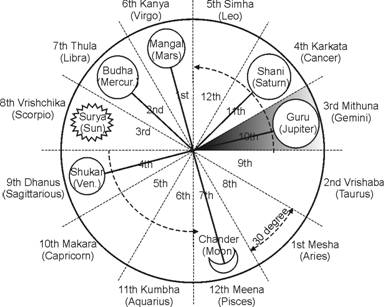
Fig 2.5 : Vedic-Jyotish-Clock top view

Fig 2.6 : Vedic-Jyotish-Clock side view
Each Grahas (planets), Bhavas (arbitrary division of space around Earth) and Rashis (division of moving group of stars) has their own attributes related to life (colors in our examples), which are discussed in the next section.
Components and their attributes
To interpret Vedic-Jyotish-Clock, we need to define major attributes (or colors in our previous example) of 12 Bhavas (arbitrary division of space around Earth) and 12 Rashis (division of moving group of stars) and 9 Grahas (planets). There are many attributes for each, but for the sake of simplicity, we have taken only one major attributes.
Twelve sectors of Bhava are -
Bhava |
Sanskrit (English) name |
Major attribute |
1 |
Tanu (Body) |
Self |
2 |
Dhana (Wealth) |
Finance |
3 |
Sahaja (Siblings) |
Discomfort |
4 |
Sukha (Happiness) |
Comfort |
5 |
Suta (Children) |
Creative |
6 |
Ripu (Enemy) |
Enemy |
7 |
Jaya (Spouse) |
Relationship |
8 |
Mrityu (Death) |
Trouble |
9 |
Dharma (Religion) |
Luck |
10 |
Karma (Work) |
Career |
11 |
Labha (Gain) |
Gain |
12 |
Vyaya (Loss) |
Loss |
Twelve sector of Rashi are -
Rashi |
Sanskrit (English) name |
Major attribute |
1 |
Mesha (Aries) |
Youthful |
2 |
Vrishaba (Taurus) |
Pleasant |
3 |
Mithuna (Gemini) |
Communication |
4 |
Karkata (Cancer) |
Emotional |
5 |
Simha (Leo) |
Independent |
6 |
Kanya (Virgo) |
Specific |
7 |
Thula (Libra) |
Unsure |
8 |
Vrishchika (Scorpio) |
Secretive |
9 |
Dhanus (Sagittarius) |
Idealistic |
10 |
Makara (Capricorn) |
Practical |
11 |
Kumbha (Aquarius) |
Universal |
12 |
Meena (Pisces) |
Adaptable |
Nine hands, Grahas (planets) are -
# |
Sanskrit (English) name |
Major attribute |
1 |
Surya (Sun) |
Soul |
2 |
Chander (Moon) |
Mind |
3 |
Mangal (Mars) |
Drive |
4 |
Budha (Mercury) |
Intelligence |
5 |
Guru (Jupiter) |
Teaching |
6 |
Shukar (Venus) |
Beauty |
7 |
Shani (Saturn) |
Restrictions |
8 |
Rahu (Dragon Head) |
Unusual |
9 |
Ketu (Dragon Tail) |
Loss |
Interpretation
Now let’s try to interpret Vedic-Jyotish-Clock i.e. fig 2.5 : Vedic-Jyotish-Clock top view. In the above tables, please look at italics and bold rows. In our Vedic-Jyotish-Clock, sector 10 (Karma/10th house) of Bhava-dial represents “Career” and sector 3 (Mithuna/Gemini) of Rashi-dial represents “Communication” and Grahas 5 (Bhraspati/Jupiter) represents “Teaching”. Vedic Astrologer may interpret that the carrier of this person is related with teaching, which involves communication.
Also later in this book, we will learn that (Mithuna/Gemini) also represents numbers and intelligence. So it can be further concluded that the carrier of this person will be related with teaching, which will involve intelligence and numbers such as mathematics or software or accounting etc.
Let’s say you want to check the personality of this person. For self (i.e.personality), we need to examine 1st Bhava (arbitrary division of space around Earth). 1st Bhava has Kanya (Virgo) and is occupied with Mangal (Mars). Kanya (Virgo) means “Specific” and Mars is signifies of “Drive”. So “Self’ is combination of “Specific’ and “Drive”, which means that person will be energetic, aggressive and demanding.
The above Vedic-Jyotish-Clock can be represented in a different graphical format, which is popularly known as Kundali (horoscope).
Kundali (Horoscope)
Graphical representation of the 9 Grahas (planets), 12 Bhavas (arbitrary division of space around Earth) and 12 Rashis (division of moving group of stars) for a specific time (i.e. time of birth), from a specific place on the Earth is called as Kundali (horoscope). Kundali is the key Vedic Jyotish (astrology) report and contains all the secrets in it. We will focus more on Kundali (horoscope) later in this book.
Attributes
As we have discussed earlier, that there are many attributes for 12 Bhavas (arbitrary division of space around Earth) and 12 Rashis (division of moving group of stars) and 9 Grahas (planets). We try to mix and match the 9 major Grahas (planets), 12 Bhavas (arbitrary division of space around Earth) and 12 Rashis (division of moving group of stars) and try to interpret the final result. Your first effort should be to understand and retain these attributes.
In India, we read and tell stories based on Puranas (old Holy Scripture in the story form). In these symbolic stories, each Graha (planet) has a corresponding character and each character has it’s own nature and attributes. By reading these stories, it becomes easy to understand and retain the nature of a Graha (planet) and it’s relation with other Graha (planets).
For example the Puranic (old holy scripture in the story form) story for shadow Graha (planets) Rahu (Dragon Head) and Ketu (Dragon Tail) goes like this. Once upon a time, there was a war between Devata (Angles) and Asura (demons). The Devata (Angles) went to Lord Brahma to seek His help. Lord Brahma suggested Sagar Manthan (churning of the ocean) and take out Amrit (nectar, a drink which leads to immortality). Since churning the ocean was a mammoth task, the cleaver Devata (Angles) invited Asura (demons) and took their help.
In Sagar Manthan (churning out the ocean), various things came out and were distributed between Devata (Angles) and Asura (demons). Then finally Amrit (nectar, a drink which leads to immortality) came out and everyone went mad after to have it.
In order to help Devata (Angles), Lord Vishnu (Supreme Lord) took the form of Mohini (beautiful lady) and offered her services to distributing Amrit (nectar, a drink which leads to immortality) equally to Devata (Angles) and Asura (demons). Both Devata (Angles) and Asura (demons) were lined up in two rows, but one of the Asura (demon) changed his appearance and sat among the Devata (Angles). While the Asura (demon) was having Amrit (nectar, a drink which leads to immortality), Chandra (Moon) and Surya (Sun) recognized the Asura (demon) and informed Mohini (beautiful lady). Then disguised Lord Vishnu (Supreme Lord) came in His real form and chopped off the head of Asura (demon) with his weapon. Though Asura's (demon) neck was separated from his body, but he did not die as he had the Amrit (nectar, a drink which leads to immortality).
From the above story of Rahu (Dragon Head) and Ketu (Dragon Tail), we can drive the following facts –
- There after the chopped out head was called 'Rahu' (Dragon Head) and his lower body as 'Ketu' (Dragon Tail). Separated head and body of Rahu (Dragon Head) and Ketu (Dragon Tail) lies in front of each other i.e. 180 degree apart.
- Since then Rahu (Dragon Head) and Ketu (Dragon Tail) wants to take revenge from Chandra (Moon) and Surya (Sun) by swallowing them and causing an eclipse. In the eclipse, Rahu's (Dragon Head) swallows Surya (Sun) or Chander (Moon) and then they come out of Rahu's (Dragon Head) chopped head. Rahu (Dragon Head) closeness to Chander (Moon, represents our “emotional mind”) causes disturbance to the material mind. Rahu will lead to unexpected and sudden problems, but ultimately for a higher cause.
- Ketu (Dragon Tail) is considered as a tale of the snake or body without head, which creates unstability and loss of material life.
- Because of their demonic nature, Rahu (Dragon Head) is considered as malefic Graha (planets). Because Lord Vishnu (Supreme Lord) killed Rahu (Dragon Head) and Ketu (Dragon Tail), these Graha (planets) give exceptionally good results in spiritual life.
So it’s always easy to remember and retain these attributes in a story form.